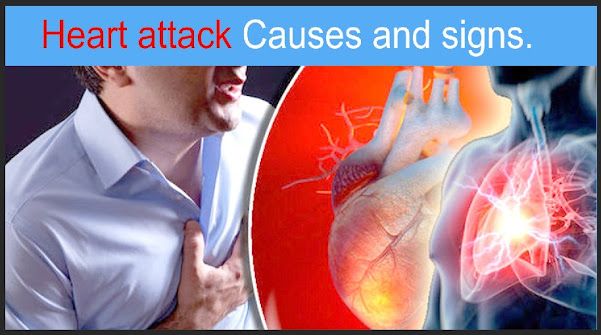Heart attack Causes and signs.
Every year, nearly 735,000 Americans have a heart
attack. In fact, it is estimated that every 34 seconds someone suffers a heart
attack in the United States. In patients who have a heart attack and arrive at
the hospital quickly, advances in treatment have reduced the number of deaths
due to heart attacks. Today, patients who recover after a heart attack are more
likely than ever to regain their previous health.
What Causes a Heart Attack?
Many heart attacks or myocardial infarctions (MI)
are caused by a complete blockage of a blood vessel in the heart called the
"coronary artery." The blockage of the coronary artery prevents blood
rich in oxygen and nutrients from reaching a section of the heart. If blood
cannot reach the heart muscle, it will die. If medical treatment is obtained
immediately, the damage can be reduced, but if a section of the heart muscle
dies, the damage is irreversible.
Heart attacks can be caused by:
A buildup of fat called "plaque" significantly blocks or narrows a coronary artery. The blockage cuts off blood
flow to the section of heart muscle fed by the artery.
A blood clot that blocks a narrowed artery by
plaque. The clot can originate in another part of the body and be carried
through the bloodstream to the narrowed artery.
A clot that forms in an area of soft plaque inside
the artery. This plaque, covered by a thin fibrous layer, is called a
vulnerable plaque. When vulnerable plaque ruptures, it can lead to the
formation of a blood clot. The clot can block blood flow to the section of
heart muscle fed by the artery.
A spasm of a coronary artery, which is a contraction
that momentarily narrows the coronary artery. This narrowing hinders or
interrupts blood flow to certain parts of the heart muscle, but it can occur in
both arteries that have plaque build-up and those that do not.
Heart attacks are divided into two types based on
their severity. The most serious type of heart attack is called an "acute
ST-segment elevation myocardial infarction" or STEMI. In a STEMI, the
coronary artery is completely blocked by a blood clot, so all of the heart
muscle that normally receives blood from the affected artery begins to die.
Doctors can determine if a person has a STEMI
because of the characteristic abnormalities seen on the electrocardiogram
(ECG). One such alteration is ST-segment elevation. This elevation indicates
that a large amount of the heart muscle has been injured. The name of this type
of heart attack is due to the elevation of the ST segment.
In a “non-ST-segment elevation myocardial
infarction” or STEMI, the coronary artery is only partially obstructed, so that
only part of the heart muscle supplied by the affected artery can be injured. A
STEMI does not produce ST-segment elevation on the electrocardiogram. For this
reason, doctors sometimes have a hard time determining whether a person is
having a heart attack or an episode of angina.
What are the symptoms of a heart attack?
The major symptoms of a heart attack are
- Chest pain or discomfort. Most heart attacks involve discomfort in the center or left side of the chest that lasts for more than a few minutes or that goes away and comes back. The discomfort can feel like uncomfortable pressure, squeezing, fullness, or pain.
- Feeling weak, light-headed, or faint. You may also break out into a cold sweat.
- Pain or discomfort in the jaw, neck, or back.
- Pain or discomfort in one or both arms or shoulders.
- Shortness of breath. This often comes along with chest discomfort, but shortness of breath also can happen before chest discomfort.
The onset of a heart attack usually manifests itself
as sudden, severe pain in the chest that patients often describe as a feeling
of pressure, as if something is crushing or squeezing their chest, or as if
they are weighing heavily on it. The pain can spread to the arm, jaw, shoulder,
back, or neck. Other possible symptoms include shortness of breath, confusion,
dizziness, lightheadedness, sweating, or nausea of unknown origin.
Not all have the classic symptoms. Some people feel
a burning sensation, similar to indigestion or heartburn, and the pain may be
concentrated in a small area of the chest. Some patients do not feel any
symptoms.
Heart attack symptoms in women may be different from those in men. Many women who have a heart attack don't know it. Women often feel burning in the upper abdomen and may have dizziness, an upset stomach, and sweating. Because they may not feel the typical pain in the left half of the chest, many women may miss the symptoms that indicate that they are having a heart attack.
Heart Attack Warning Signs.
How is a heart attack diagnosed?
In addition to talking with you and checking your pulse and blood pressure, the emergency room staff will usually do the following tests. An electrocardiogram (ECG) to determine which of the coronary arteries is blocked and monitor your heart rhythm.
A blood test to determine how much damage has
occurred by detecting certain enzymes that pass from injured heart muscle cells
into the bloodstream. The enzymes that are generally tried to detect are CK-MB
(the myocardial band of the enzyme creatine kinase), myoglobin, and cardiac
troponins T and I, which are released into the bloodstream when the heart
muscle is damaged. They may also try to detect the levels of fibrinogen and
C-reactive protein (CRP) in the bloodstream.
A chest x-ray to determine if your heart is enlarged or if there is fluid in your lungs. When it has stabilized, doctors may order further tests to determine how much damage your heart has suffered.
A thallium stress test, a nuclear medicine study, involves injecting a radioactive substance into the bloodstream to see
how the blood flows through the arteries. This study can determine if parts of
the heart muscle are damaged or dead, or if an artery is significantly narrowed.
An echocardiogram, which allows determining if the
heart muscle is damaged, by studying the movement of the lower-left chamber
(the left ventricle). A measurement that is typically taken during an
echocardiogram is the left ventricular ejection fraction or LVEF of the heart.
During a heartbeat, which is a two-phase pumping action, the heart contracts
and relaxes. When the heart contracts, it ejects (or ejects) blood from the
ventricles. When the heart relaxes, the ventricles fill with blood. No matter
how strong the contraction, the heart never ejects all the blood from the
ventricles. LVEF is the percentage of blood expelled from the left ventricle
with each beat. The LVEF in a healthy heart is between 55 and 70 percent. LVEF
may be lower if the heart attack has damaged the heart muscle. Echocardiography
is also used to see if the movement of the heart wall has decreased (this is
known as "hypokinesia").
A coronary angiography, a study performed in a
cardiac catheterization laboratory, administering a mild sedative. A dye is
injected into the bloodstream to produce an "animated" x-ray of the
heart's activity and blood flow through the valves and arteries (called an
"angiogram"). The angiogram shows how many obstructions there are and
how severe they are. Doctors often do this study to determine what would be the
most effective treatment. Outcomes of a heart attack.
The outcome of a heart attack depends on several
factors:
Where the coronary obstruction occurs. Blockages on
the left side of the heart are generally more dangerous.
If there was a rhythm disturbance. When the
obstruction also causes an irregular pulse called an arrhythmia, it could lead
to sudden death. There can be both a fast heartbeat (called
"tachycardia") and rapid, uncoordinated contractions (called
"ventricular fibrillation"). Ventricular fibrillation interrupts
blood flow, which must be quickly restored by cardiopulmonary resuscitation
(CPR) or electrical treatment (defibrillation).
If the heart receives blood from another source. In
some cases, the body responds to gradual blockage of an artery by dilating
another vessel that supplies blood to the same part of the heart. This vessel
becomes what is called a "collateral source of blood supply." In that
case, the damage caused by the obstruction would be less.
How quickly assistance is received. In most cases,
getting medical help within an hour of the attack will limit the loss of heart
muscle.
What treatments are there?
The goals of treatment after a heart attack are to
restore blood flow to the heart muscle, normalize the pulse, and give the heart
time to recover.
The development of drugs capable of dissolving clots, called 'thrombolytic agents', such as streptokinase, urokinase, and tissue plasminogen activators, has increased survival rates in patients who have suffered a heart attack when they are administered as soon as possible after an attack. The term "thrombolysis" means "clot-dissolving" and that is exactly what these drugs do. In some cases, they can do it in a matter of minutes. To be most effective they should be given as soon as possible after a heart attack.
Most patients respond well to thrombolytic agents.
But if they are in a facility that has a cardiac catheterization laboratory,
they may not receive these clot-dissolving medications but may be taken
immediately to the cardiac catheterization laboratory, where techniques such as
balloon angioplasty and placement of stents to open blood vessels. Sometimes
patients who do not respond well to these interventions may need an additional
emergency procedure, such as a coronary bypass or a related procedure.
Patients who have had a heart attack may also
receive antiplatelets such as aspirin and blood thinners (anticoagulants) to
prevent clots from forming or enlarging. Oxygen can also be given to increase
the amount of oxygen in the blood that is still flowing through the heart. Pain
relievers may be given to reduce pain. Some patients are also given medications
to slow the heart rate, dilate and relax the blood vessels, and reduce the work
of the heart.
Rest is important immediately after a heart attack. But within a few days, the patient must get up and move, walk a few steps, and do other types of limited physical exercise. Studies show that the heart benefits from physical exercise, even after a heart attack.
Sometimes after a heart attack, an aneurysm forms in
the left ventricle, which is the main pumping chamber of the heart. If a
section of the heart wall is damaged after a heart attack, scars form and the
heart wall becomes thinner and weaker. This could lead to the formation of a
ventricular aneurysm. The weakened area of the aneurysm does not work well,
causing the heart to work harder to pump blood to the rest of the body.
Ventricular aneurysms can cause shortness of breath, chest pain, or an
irregular pulse (arrhythmia). If a ventricular aneurysm is causing congestive
heart failure, left ventricular failure, or arrhythmia, your doctor may
recommend surgery.








0 Comments
don't spam comments, please ...